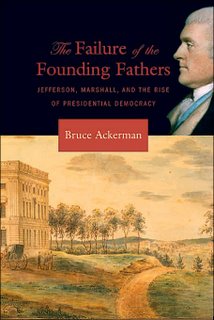The Plebicitarian Presidency
 I had to make a decision this morning whether to return to the library or keep and read Bruce Ackerman’s book, The Failure of the Founding Fathers: Jefferson, Marshall, and the Rise of Presidential Democracy (2006.) I decided to keep it.
I had to make a decision this morning whether to return to the library or keep and read Bruce Ackerman’s book, The Failure of the Founding Fathers: Jefferson, Marshall, and the Rise of Presidential Democracy (2006.) I decided to keep it.The book addresses an interesting development in US history. In the 1801 election, Thomas Jefferson and his Republican party had won the popular vote. But the electoral college was split down the middle. So the decision was thrown into the House.(If this sounds familiar it’s because we still have the electoral college, whose vote is not always for the guy who won the plebiscite.)
The Federalists controlled the House and after 35 ballots there was still no president. If the Federalists had put their man, Aaron Burr (yes, that Aaron Burr), into the presidency, anti-Federalists state militias were prepared to march on the capital.
A compromise was reached, Jefferson became president, and thus began the two-party system in this country and the strong presidency with claims of a mandate for broad change.
The Federalists withered away to be replaced by the Whigs, who withered away to be replaced in 1854 by the Republican Party. Meanwhile Jefferson’s Republicans became first the Republican Democrats and eventually the Democratic Party we know today.
Fascinating stuff.


2 Comments:
Thomas Jefferson is a fascinating figure I'd really like to investigate one of these days. Anyone with that large a library is someone worth knowing about.
As you know, the Library of Congress was founded when Congress bought Jefferson's library. That's why the LC cataloging system is so strange. It was devised to catalog Jefferson's collection, which didn't include many computer manuals or books about DNA. md
Post a Comment
Subscribe to Post Comments [Atom]
<< Home